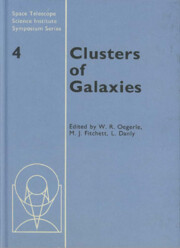Book contents
- Frontmatter
- Contents
- Preface
- Participants
- Chapter 1 Cosmology and Cluster Formation
- Chapter 2 Clusters of Galaxies: Structure, Infall, and Large-Scale Distribution
- Chapter 3 Cosmogony with Clusters of Galaxies
- Chapter 4 Cosmogony and the Structure of Rich Clusters of Galaxies
- Chapter 5 The Dark Matter Distribution in Clusters
- Chapter 6 The Effect of the Cluster Environment on Galaxies
- Chapter 7 Evidence for Gas Deficiency in Cluster Galaxies
- Chapter 8 Properties of Galaxies in Groups and Clusters
- Chapter 9 Dynamical Evolution of Clusters of Galaxies
- Chapter 10 Hot Gas in Clusters of Galaxies
- Chapter 11 Hydrodynamic Simulations of the Intracluster Medium
- Chapter 12 Evolution of Clusters in the Hierarchical Scenario
- Chapter 13 Distant Clusters as Cosmological Laboratories
- Chapter 14 Future Key Optical Observations of Galaxy Clusters
- Chapter 15 Cluster Research with X-ray Observations
- Plate section
Chapter 6 - The Effect of the Cluster Environment on Galaxies
Published online by Cambridge University Press: 06 July 2010
- Frontmatter
- Contents
- Preface
- Participants
- Chapter 1 Cosmology and Cluster Formation
- Chapter 2 Clusters of Galaxies: Structure, Infall, and Large-Scale Distribution
- Chapter 3 Cosmogony with Clusters of Galaxies
- Chapter 4 Cosmogony and the Structure of Rich Clusters of Galaxies
- Chapter 5 The Dark Matter Distribution in Clusters
- Chapter 6 The Effect of the Cluster Environment on Galaxies
- Chapter 7 Evidence for Gas Deficiency in Cluster Galaxies
- Chapter 8 Properties of Galaxies in Groups and Clusters
- Chapter 9 Dynamical Evolution of Clusters of Galaxies
- Chapter 10 Hot Gas in Clusters of Galaxies
- Chapter 11 Hydrodynamic Simulations of the Intracluster Medium
- Chapter 12 Evolution of Clusters in the Hierarchical Scenario
- Chapter 13 Distant Clusters as Cosmological Laboratories
- Chapter 14 Future Key Optical Observations of Galaxy Clusters
- Chapter 15 Cluster Research with X-ray Observations
- Plate section
Summary
Abstract. Various observations indicate that the cluster environment can affect the structure and dynamics of galaxies. This review concentrates on the effect the environment can have on three of the most basic properties of a galaxy; the morphological type, the size, and the distribution of mass. A reexamination of the morphology - density relation suggests that the fundamental driver may be related to some global property of the cluster, such as the distance from the cluster center, rather than some local property, such as membership in a local subclump within the cluster. While there is good evidence that the size of a galaxy can be increased (i.e., cD galaxies) or decreased (i.e., early type galaxies near the centers of clusters) by the cluster environment, it is not clear what physical mechanism is responsible. There is tentative evidence that rotation curves of spiral galaxies near the centers of clusters are falling, perhaps indicating that the dark halo has been stripped off. Rotation curves for spiral galaxies in compact groups are even more bizarre, providing strong evidence that the group environment has affected the kinematics of these galaxies.
INTRODUCTION
Perhaps the three most basic questions an extragalactic astronomer might be asked are:
Why are some galaxies flattened into disks while others are elliptical in shape?
How big are galaxies?
How massive are galaxies?
Although we can fill journals with details about galaxies, an astronomer cannot really answer these three basic questions with any confidence.
- Type
- Chapter
- Information
- Clusters of Galaxies , pp. 139 - 176Publisher: Cambridge University PressPrint publication year: 1990
- 4
- Cited by



